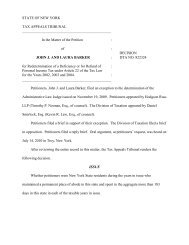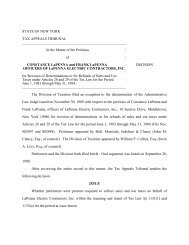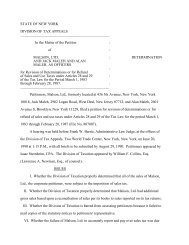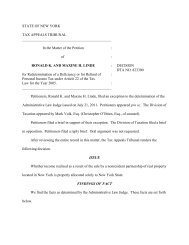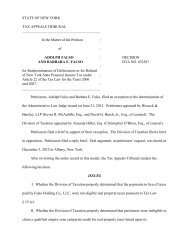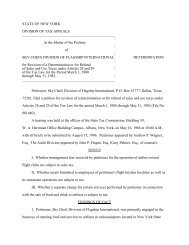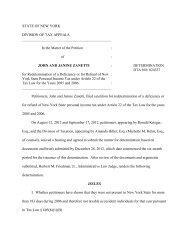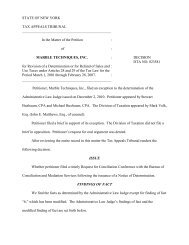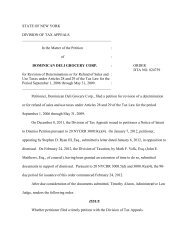TATE OF NEW YORK DIVISION OF TAX APPEALS In the Matter
TATE OF NEW YORK DIVISION OF TAX APPEALS In the Matter
TATE OF NEW YORK DIVISION OF TAX APPEALS In the Matter
Create successful ePaper yourself
Turn your PDF publications into a flip-book with our unique Google optimized e-Paper software.
“or if a return when filed [was] incorrect or insufficient, <strong>the</strong> amount of tax due shall be<br />
determined [by <strong>the</strong> Division of Taxation] from such information as may be available. If<br />
necessary, <strong>the</strong> tax may be estimated on <strong>the</strong> basis of external indices . . . .” (Tax Law §<br />
1138[a][1].) When acting pursuant to section 1138(a)(1), <strong>the</strong> Division is required to select a<br />
-16<br />
method reasonably calculated to reflect <strong>the</strong> tax due. The burden <strong>the</strong>n rests upon <strong>the</strong> taxpayer to<br />
demonstrate that <strong>the</strong> method of audit or <strong>the</strong> amount of <strong>the</strong> assessment was erroneous (see <strong>Matter</strong><br />
of Your Own Choice, <strong>In</strong>c., Tax Appeals Tribunal, February 20, 2003).<br />
D. The standard for reviewing a sales tax audit where external indices were employed was<br />
set forth in <strong>Matter</strong> of Your Own Choice, <strong>In</strong>c., as follows:<br />
To determine <strong>the</strong> adequacy of a taxpayer’s records, <strong>the</strong> Division must first<br />
request (<strong>Matter</strong> of Christ Cella, <strong>In</strong>c. v. State Tax Commn., [102 AD2d 352, 477<br />
NYS2d 858] supra) and thoroughly examine (<strong>Matter</strong> of King Crab Rest. v. Chu,<br />
134 AD2d 51, 522 NYS2d 978) <strong>the</strong> taxpayer’s books and records for <strong>the</strong> entire<br />
period of <strong>the</strong> proposed assessment (<strong>Matter</strong> of Adamides v. Chu, 134 AD2d 776,<br />
521 NYS2d 826, lv denied 71 NY2d 806, 530 NYS2d 109). The purpose of <strong>the</strong><br />
examination is to determine, through verification drawn independently from<br />
within <strong>the</strong>se records (<strong>Matter</strong> of Giordano v. State Tax Commn., 145 AD2d 726,<br />
535 NYS2d 255; <strong>Matter</strong> of Urban Liqs. v. State Tax Commn., 90 AD2d 576, 456<br />
NYS2d 138; <strong>Matter</strong> of Meyer v. State Tax Commn., 61 AD2d 223, 402 NYS2d<br />
74, lv denied 44 NY2d 645, 406 NYS2d 1025; see also, <strong>Matter</strong> of Hennekens v.<br />
State Tax Commn., 114 AD2d 599, 494 NYS2d 208), that <strong>the</strong>y are, in fact, so<br />
insufficient that it is ‘virtually impossible [for <strong>the</strong> Division of Taxation] to verify<br />
taxable sales receipts and conduct a complete audit’ (<strong>Matter</strong> of Chartair, <strong>In</strong>c. v.<br />
State Tax Commn., 65 AD2d 44, 411 NYS2d 41, 43; <strong>Matter</strong> of Christ Cella, <strong>In</strong>c.<br />
v. State Tax Commn., supra), ‘from which <strong>the</strong> exact amount of tax due can be<br />
determined’ (<strong>Matter</strong> of Mohawk Airlines v. Tully, 75 AD2d 249, 429 NYS2d<br />
759, 760).<br />
Where <strong>the</strong> Division follows this procedure, <strong>the</strong>reby demonstrating that <strong>the</strong><br />
records are incomplete or inaccurate, <strong>the</strong> Division may resort to external indices to<br />
estimate tax (<strong>Matter</strong> of Urban Liqs. v. State Tax Commn., supra). The estimate<br />
methodology utilized must be reasonably calculated to reflect taxes due (<strong>Matter</strong> of<br />
W. T. Grant Co. v. Joseph, 2 NY2d 196, 159 NYS2d 150, cert denied 355 US<br />
869, 2 L Ed 2d 75), but exactness in <strong>the</strong> outcome of <strong>the</strong> audit method is not<br />
required (<strong>Matter</strong> of Markowitz v. State Tax Commn., 54 AD2d 1023, 388<br />
NYS2d 176, affd 44 NY2d 684, 405 NYS2d 454; <strong>Matter</strong> of Cinelli, Tax Appeals




